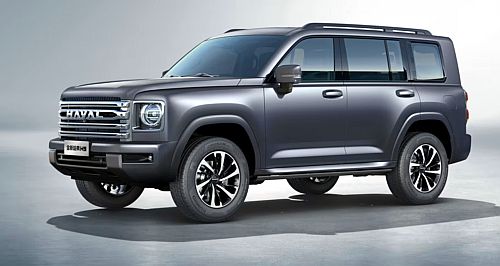Future models - GWM - HavalGWM set to offer V6 Tank, Haval H9 soonChinese importer to up the ante against Jeep’s Wrangler and Toyota’s LandCruiser Prado18 Jan 2024 By MATT BROGAN GREAT WALL MOTORS looks set to introduce a more powerful V6 version of its popular Tank 300 (known as the Tank 330) alongside an all-new Haval H9 in the very near future.
If offered locally, the two models will expand GWM’s Australian portfolio with respective rivals to the Jeep Wrangler and Toyota LandCruiser Prado – albeit at a more reasonable price.
For the Tank 330 we find a 265kW twin-turbocharged V6 petrol engine displacing 3.0 litres in place of the 162kW 2.0-litre four-cylinder turbo-petrol offered currently (from $46,990 drive-away).
The figures also see the six-cylinder model output more than the 2.0-litre petrol-electric hybrid, which offers 255kW (from $55,990 d/a).
The highly specified model appears to be based upon the Tank 300 Frontier Limited Edition with accessory body cladding, larger 18-inch alloy wheels and a tailgate spoiler. It also sports a rectangular three-bar grille, round LED headlights, metal bumpers, a vented bonnet, and accessory luggage racks.
Reportedly, the Tank 330 is said to offer improved approach and departure angles when compared with the 300, as well as additional wading clearance of 900mm (+200mm).
At this stage, no further details are known, though Car News China suggests the model came into being following a crowd-funding exercise by GWM fans – and was sold out in under six minutes.
It is expected to go on sale in China later this year.
At the same time as details of the GWM Tank 330 come to light, we find more information on the release of the second-generation Haval H9.
Details of the body-on-frame four-wheel drive SUV – which is similar in size to the Toyota LandCruiser Prado – were revealed on Chinese social media this week outlining an unchanged 167kW 2.0-litre four-cylinder turbo-petrol engine and eight-speed automatic combination.
A two-wheel drive model featuring a 137kW 2.4-litre four-cylinder turbo-diesel and nine-speed automatic pairing is also tipped to follow.
The GWM Haval H9 was last sold in Australia in 2021 and missed out on many of the interior features noted in the updated model. The 2024 version of the H9 includes a larger central infotainment array, digital instrument panel, and a new ventilation design for the dashboard outlets.
GWM Australia says it has no current plans to expand the Tank 300 range, but that it is considering the Haval H9 for the local market.
GoAuto understands the Tank 500 is also on the importer’s wish list.
“It’s positive to see new GWM products, such as the H9 and Tank 330 being launched, and we always watch with interest from a local perspective on the unveiling of new models like these,” a GWM Australia spokesperson told GoAuto.
“With the H9, we’re evaluating this new model as part of our wider SUV strategy and will be in a position to announce more on that front in the coming months.
“With Tank, our current focus is on continuing the successful launch of Tank 300. We’re happy with the current line-up and powertrain options and have no plans to add more models to the Tank 300 range at this stage.
“Additionally, our local team is working on an expanded genuine GWM accessory range for all models including the Tank 300.”
With CarNewsChina
 Read more13th of December 2023  2024 GWM Tank 300 Hybrid ReviewHybridised Tank 300 comprehensively out-performs its petrol-powered sibling20th of July 2023  2023 GWM Tank 300 ReviewIs the GWM Tank 300 just another SUV masquerading as a four-wheel drive? We find out19th of July 2023  2023 GWM Ora Standard Range ReviewLike or loathe it, the odd-ball GWM Ora is well-priced and enjoyable city-centric EVAll future models Alfa Romeo Alfa Romeo Abarth Abarth Audi Audi Aston Martin Aston Martin BMW BMW Bentley Bentley Chrysler Chrysler Chevrolet Chevrolet Dodge Dodge Citroen Citroen Ferrari Ferrari DS DS Ford Ford Fiat Fiat FPV FPV Foton Foton Haval Haval Great Wall Great Wall Honda Honda Holden Holden Hyundai Hyundai HSV HSV Isuzu Isuzu Infiniti Infiniti Jeep Jeep Jaguar Jaguar Lamborghini Lamborghini Kia Kia Lexus Lexus Land Rover Land Rover Mazda Mazda Maserati Maserati Mercedes-Benz Mercedes-Benz McLaren McLaren Mini Mini Nissan Nissan Mitsubishi Mitsubishi Peugeot Peugeot Opel Opel Proton Proton Porsche Porsche Renault Renault Ram Ram Saab Saab Rolls-Royce Rolls-Royce Smart Smart Skoda Skoda Subaru Subaru SsangYong SsangYong Tesla Tesla Suzuki Suzuki Toyota Toyota Volvo VolvoMotor industry news |
Click to shareGWM modelsAll future models Alfa Romeo Alfa Romeo Abarth Abarth Audi Audi Aston Martin Aston Martin BMW BMW Bentley Bentley Chrysler Chrysler Chevrolet Chevrolet Dodge Dodge Citroen Citroen Ferrari Ferrari DS DS Ford Ford Fiat Fiat FPV FPV Foton Foton Haval Haval Great Wall Great Wall Honda Honda Holden Holden Hyundai Hyundai HSV HSV Isuzu Isuzu Infiniti Infiniti Jeep Jeep Jaguar Jaguar Lamborghini Lamborghini Kia Kia Lexus Lexus Land Rover Land Rover Mazda Mazda Maserati Maserati Mercedes-Benz Mercedes-Benz McLaren McLaren Mini Mini Nissan Nissan Mitsubishi Mitsubishi Peugeot Peugeot Opel Opel Proton Proton Porsche Porsche Renault Renault Ram Ram Saab Saab Rolls-Royce Rolls-Royce Smart Smart Skoda Skoda Subaru Subaru SsangYong SsangYong Tesla Tesla Suzuki Suzuki Toyota Toyota Volvo VolvoMotor industry news |
















Facebook Twitter Instagram